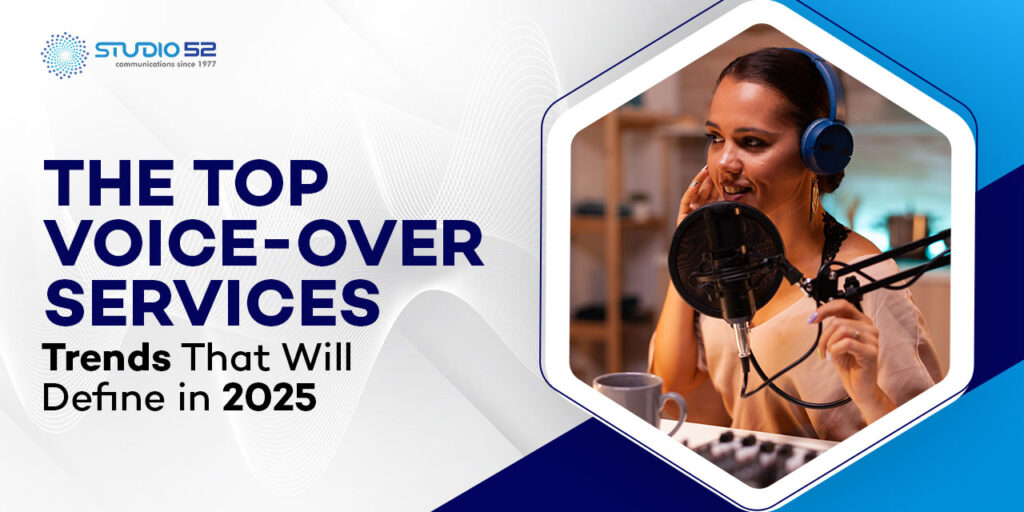The demand for voice over content is changing fast. From on-demand streaming platforms to immersive eLearning and multilingual digital marketing, voice is no longer a supporting function. It is a strategic tool for businesses to connect with diverse, remote, and culturally distinct audiences.
In 2025, several factors are shaping how brands use voice. Content has become more global, attention spans are shrinking, and voice is now expected to do more than just narrate, it needs to influence, localise, and sometimes even replace human interaction. The role of professional voice over artists is more critical than ever, not just for delivery, but for shaping the emotional tone and cultural authenticity of content.
This blog highlights the most impactful voice over trends in 2025, explores the technologies reshaping the industry, and offers insights into how businesses can stay ahead.
Table of Content
Why Voice Over Services are Transforming the Market
In an era where brands publish content at scale, voice over services are essential. Organisations that operate across regions and languages cannot rely on written content alone. Voice enables them to scale storytelling while still being personal and effective.
2025 will bring tighter content regulations around accessibility, especially with WCAG and ADA updates enforcing the use of audio guides and narration in digital platforms. Whether it’s for explainer videos, mobile apps, podcasts, or internal communications, the need for consistent, localised voice output is becoming integral.
Importantly, voice over is not just about speaking clearly, it’s about the professional voice over artists interpreting tone, applying emotional context, and helping brands maintain human presence, even in automated environments. Businesses using AI-generated voice often discover that without expert voice editing or input, delivery falls flat. Human quality control is becoming a standard part of the production chain.
Top Voice Over Services Trends in 2025
Let’s explore the defining voice over trends in 2025, based on market demand, user behaviour, and production technologies:
- Personalised Voice Delivery: Brands are customising audio content for different user personas. AI tools allow dynamic pacing, tone adjustments, and gender switching, tailored to regional preferences. This level of personalisation is being integrated into ad tech, eLearning, and onboarding processes.
- Voice Localisation at Scale: With content being distributed globally, localisation is not just translation. It involves cultural context, local expressions, and tone shifts. Businesses are now maintaining a roster of professional voice over artists across multiple regions to ensure true localisation.
- AI + Human Voice Fusion: Synthetic voices can mimic style and tone, but emotional resonance still comes from human touch. Many projects now start with AI-generated drafts but are completed with human edits and quality passes. This trend is helping businesses scale content without compromising experience.
- Platform-Based Voice Integration: Voice over content is now embedded directly into CRMs, customer support platforms, mobile apps, and internal dashboards. The trend of embedded narration is especially visible in onboarding and app tutorials.
- Long-Term Voice Branding: Businesses are creating long-term associations by using the same voice artists across formats like ads, IVRs, internal videos, and more. This builds a consistent sonic identity. Choosing the best voice over artist for brand voice is a strategic move.
Emerging Tools and Technologies in Voice Over Services
Voice over production is no longer limited to studios. Tools today are decentralising voice creation, making it possible to record, process, and deliver high-quality audio from anywhere in the world.
Key Innovations:
- AI voice cloning platforms allow synthetic replication of approved voices, which can then be used for high-volume content.
- Collaborative direction tools now support live feedback sessions, enabling clients to guide the recording remotely.
- Multimodal engines combine voice with gesture and expression mapping for VR and AR applications.
Industries Adopting Voice Over Trends
The impact of these voice-over trends in 2025 is already visible across sectors:
- Education & eLearning: Educational content is being voiced in regional languages for both public and private platforms. Students engage more when the voice speaks their dialect. Here, the role of professional voice over artists is vital in ensuring age-appropriate tone and clarity.
- Gaming & Entertainment: Character voices are becoming more culturally grounded. Games now release with multiple voice tracks tailored to different regions. Developers rely on the best voice over artist to create characters that are realistic, immersive, and regionally relatable.
- Marketing & Retail: Dynamic audio helps adapt to listener behaviour. A single campaign may feature ten different voice variations. Voice over services here are tied closely with marketing automation tools.
- Healthcare: Voice is now used in diagnostics, patient education, and mental health apps. In high-sensitivity sectors like this, clarity, empathy, and correct pacing are critical, something only experienced professional voice over artists can ensure.
Learn More: The Ultimate Guide to Choosing the Right Voice-Over Services for Your Industry
Challenges & Opportunities
Despite the growth, the industry has hurdles that businesses need to navigate.
Challenges:
- Voice Rights Abuse: Unauthorised replication of artists’ voices is becoming a serious concern.
- Quality Inconsistency: Not all AI-generated voice solutions meet industry standards.
- Dialect Limitations: Many tools underperform in non-English languages or with regional accents.
Opportunities:
- Legal Frameworks for Voice Licensing: Artists and agencies are pushing for global voice copyright standards.
- Voice Datasets Expansion: Growing datasets for underrepresented languages mean more accurate voice generation tools.
- Collaborative Ecosystems: Studios, artists, and tech providers are forming tighter ecosystems to provide scalable, managed solutions.
Tips for Businesses to Stay Ahead
Staying competitive in 2025 requires deliberate planning. Here’s what smart companies are doing:
- Build Long-Term Voice Talent Partnerships: Choose from a diverse talent pool of professional voice over artists and invest in consistency.
- Audit Your Voice Content Pipeline: From tone to timing, ensure your outputs match your brands ethos and regional goals.
- Balance AI and Human Effort: Use AI for bulk and repetition, but bring in human oversight where tone, culture, and creativity matter.
- Invest in Training: Upskill your internal teams on basic voice-editing tools to improve turnaround time.
- Choose the Best Voice Over Artist for Your Core Brand Content: This helps in building long-term audience familiarity and engagement.
Conclusion
The voice over trends in 2025 will be defined by speed, scalability, and cultural precision. Businesses that treat voice as a strategic asset, rather than a last-minute addition, will deliver stronger content, better engagement, and more trust across their audience base.
At Studio52, we understand the intricacies of voice, from crafting immersive multilingual campaigns to providing enterprise-grade voice over for training, healthcare, gaming, and more. Whether you’re experimenting with AI-based delivery or need the unmistakable impact of a human voice, we help you find the right balance.
Talk to our team today and explore our end-to-end voice over services that keep you ahead of the curve.
FAQs
Q1. What are the top voice over services trends for 2025?
A1. The biggest voice over trends in 2025 include AI-generated voices, multilingual voice overs, hyper-localized accents, interactive voice technology, and the growing demand for authentic human voice artists in commercials, e-learning, gaming, and audiobooks.
Q2. How is AI changing the voice over industry in 2025?
A2. AI voice technology is transforming the industry by making production faster and more cost-effective. However, brands still prefer human voice artists for emotional connection and authenticity, making AI and human collaboration a key trend in 2025.
Q3. Why is multilingual voice over important in 2025?
A3. With global content consumption on the rise, multilingual voice overs help businesses connect with diverse audiences. In 2025, demand for Arabic, Spanish, Mandarin, and regional dialects is increasing across films, ads, and e-learning platforms.
Q4. What industries will benefit most from voice over services in 2025?
A4. Industries like e-learning, gaming, advertising, film production, corporate training, and IVR/telecom are seeing the biggest growth. Interactive media and the Metaverse are also fueling new opportunities for voice actors.
Q5. Are natural and authentic voices more in demand than synthetic ones?
A5. Yes. While synthetic voices are growing, brands increasingly value authentic, relatable human voices to build trust and emotional engagement with their audiences in 2025.
Q6. How does localization impact voice-over trends in 2025?
A6. Localization is crucial as brands target specific regions. Voice-overs in local dialects, such as Khaleeji Arabic, Latin American Spanish, or regional English accents, are driving better cultural connection and audience engagement.
Q7. Will AI replace human voice actors in the future?
A7. AI is a powerful tool, but it won’t fully replace human voice actors. Instead, AI will handle routine or low-budget projects, while human artists will dominate creative, emotional, and high-impact storytelling in 2025 and beyond.
Q8. How can businesses choose the right voice over service in 2025?
A8. Businesses should consider service providers with expertise in multiple languages, access to both AI and human voice options, strong localization skills, and experience across industries like e-learning, media, and advertising.


